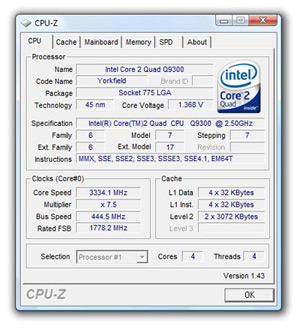Intel Core 2 Quad Q9300 Processor
While a 95W TDP rating doesn’t seem extremely power-friendly, this TDP rating is actually quite good in comparison to other quad-core solutions on the market. AMD’s new Phenom 9850 chips run in the range of 125W TDP, and Intel’s previous generation quad-cores run art 105W+. While the spec sheets will tell you one story, we can say that after testing this chip first hand, it’s very friendly in terms of power consumption and heat-production for a quad-core. The Q9300 doesn’t need large, copper contraptions with fancy heatpipes and high-speed fans to stay cool (although, they help). The chip is perfectly happy running on fairly basic cooling systems with low-to-moderate speed fans. When idling, our Q9300 chip ran just above room temperature, and only hit temperatures of roughly 125°F / 51°C under sustained processing loads. For a quad-core with this much computing power under the hood, that's pretty impressive.
Of course, this makes for a beautiful segue to talk about overclocking. As the Q9300 runs cool under sustained loads at its stock 2.5 GHz clock rate, it’s only natural to think that the chip can run at much higher clock speeds when pushed. Being the low-end model of a new family of processors, people will be looking at this chip to be the new low-cost, high-speed overclocking price/performance champ that the Q6600 once was, and still is. From our tests thus far, the Q9300 does indeed surpass the overclockability of the Q6600, but not by the huge amounts we had originally expected. Here’s why.
The Q9300 runs with a 7.5x multiplier at 1333 MHz front side bus, which isn’t ideal for overclocking. The multiplier can be adjusted downwards, but it’s not incredibly flexible, leaving potential overclockers to rely on high front side bus speeds. Most modern motherboards don’t have any trouble hitting 1666 MHz FSB speeds and up, but when you get to the areas of 1800-1900 MHz and up, you really have to rely on the motherboard in order to help you unlock the true potential of this chip. With our tests, with a brand, spanking new XFX nForce 790i SLI motherboard, we were able to coax a maximum clock speed of 3.4 GHz out of our (2.5 GHz stock-clocked) Q9300 sample processor. Early reports from users getting these chips in hand are showing similar results.
In order to reach clock speeds of 3.3 GHz and higher, the Q9300 requires a voltage boost (up to 1.325V) in order to stay happy. Even with high clock speeds and increased voltage levels, our chip ran surprisingly cool throughout our tests. At 3.4 GHz, our chip would run through all of our benchmarks but one (a video encoding benchmark), no matter what voltage or cooling we threw at it. We found the sweet spot of overclocking on the Q9300 to be 3.33 GHz, which was rock solid throughout all of our testing. We’ve included a set of benchmarks at this overclocked speed in the following pages.
Core 2 Quad Q9300 - Stock Speeds |
 Core 2 Quad Q9300 - 3.33 GHz O/C |
One of the most interesting areas to look at is the Core 2 Quad Q9300’s power consumption. With Intel’s 45nm process technology, a fairly low clock speed, and a small amount of cache, we would expect power consumption levels to be somewhat low in comparison to other quad-core solutions on the market today. We ran our power consumption numbers with our standard testbed (seen in the following page) with identical hardware configurations. Power consumption levels are tested for the whole system (not just the processors) through a hardware AC wattage meter. Idle numbers are taken at the Windows desktop after the OS has loaded and settled down. Full load meters are taken during our Cinebench R10 test when all four cores are active and running at maximum consumption levels. Power management features (EIST, C1E, Speedstep, PowerNow) were disabled across the board in order to keep consistency.


What is most impressive is that even when overclocked to 3.3 GHz, the power consumption of this processor is roughly at the same level as a Core 2 Quad Q6600 processor at a stock 2.4 GHz. Even with nearly a 1 GHz clock speed difference there is nearly no difference in power consumption, which is a testament to Intel's Penryn microarchitecture and its advanced manufacturing prowess.






